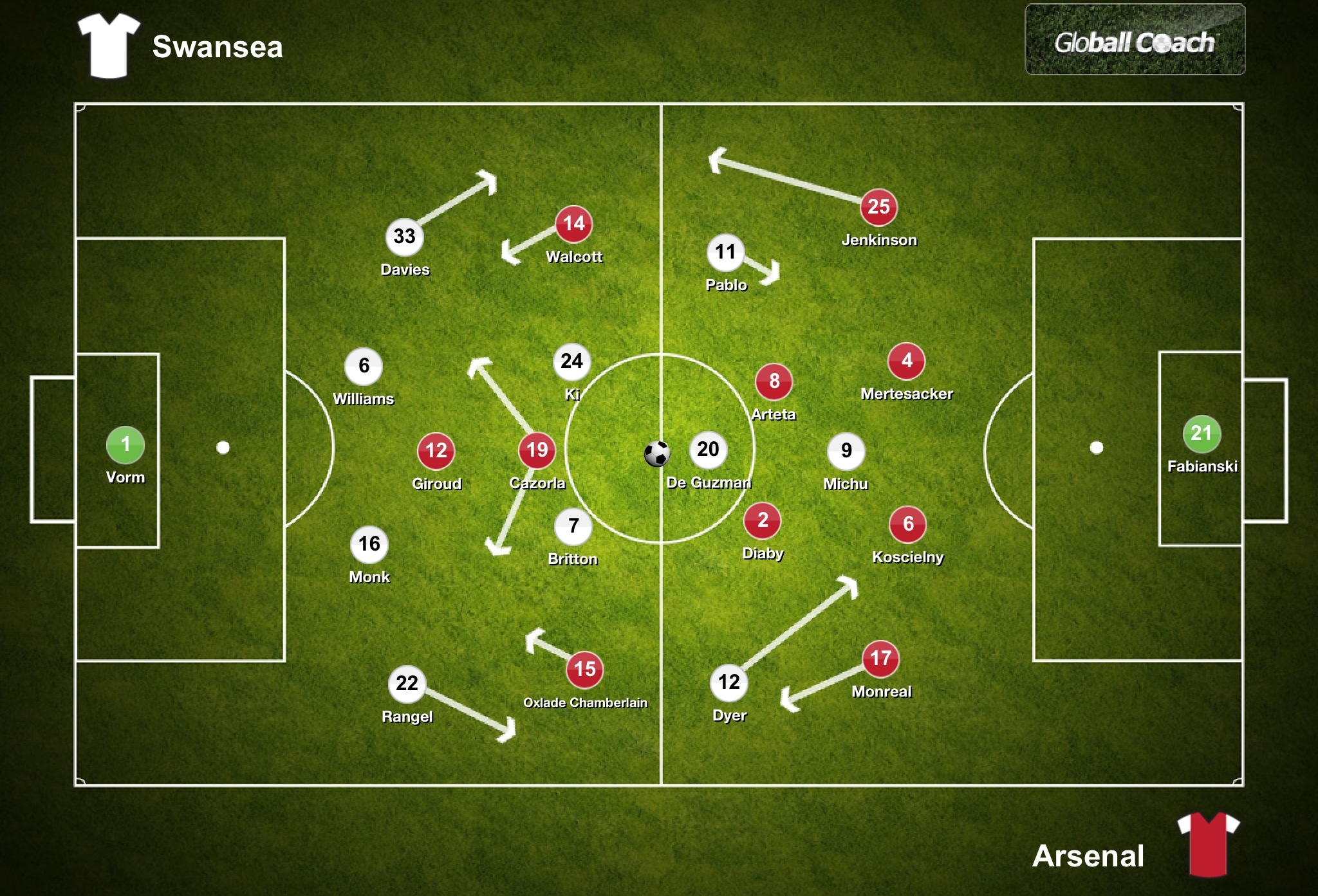Two the Premier League’s possession orientated teams met at the Liberty Stadium on Saturday and produced a game with some fine passing but very little in the way of clear chances until the latter stages of the game.
Having secured an essential three points however, I doubt Arsene Wenger will be complaining.
Line Ups
Laudrup made two changes to his starting line up. Both Moore and Routledge were substitutes and replaced by Dyre and Pablo. Without a striker in the starting eleven, Michu was asked to play there rather than his favoured position behind the lone striker.
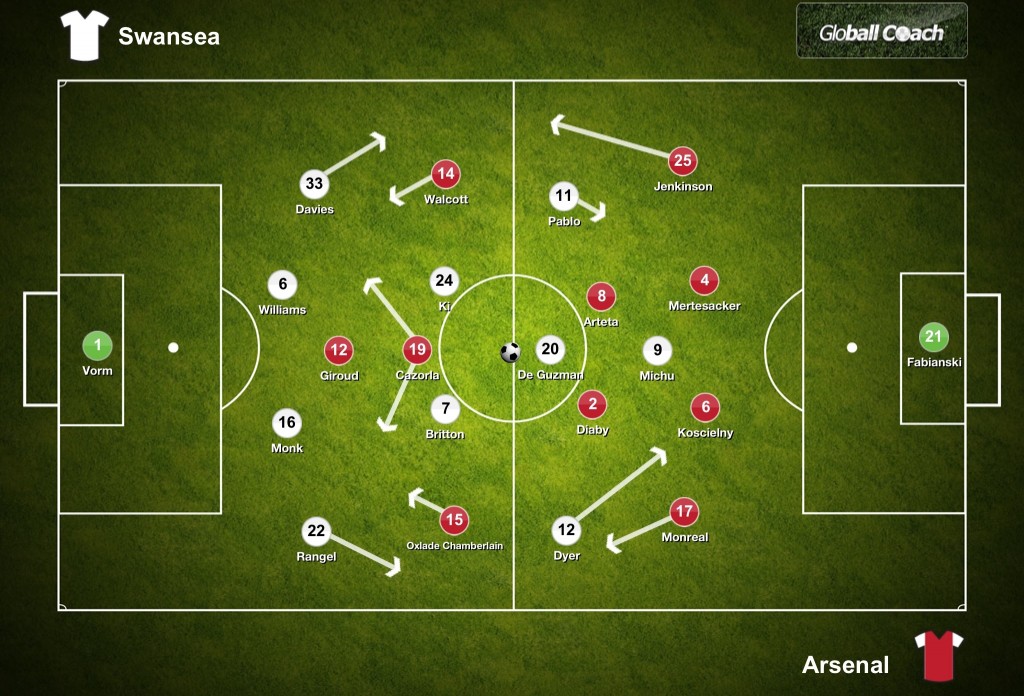
There were four changes in the Arsenal team, from the side that lost the North London derby two weeks earlier. Szezcsny was on the becnh with Fabianski remaining in the team following his midweek appearance in the Champions League. Vermaelen joined the Pole on the bench with Koscielny partnering Mertesacker in defence. Diaby took the place of Ramsay whilst the injured Wilshere was replaced by Oxlade Chamberlain.
Both sides lined up in 4-2-3-1 formations.
Pretty Football
Swansea dominated the opening exchanges, as they did the whole game, with 57% possession compared to Arsenal’s 43%. Considering that both sides are in the top five for average possession in each game, this was quite a differential.
This was a very un-Laudrup like performance from Swansea though. Despite attempting 619 passes during the game, just 119 were in the final third of the pitch. In many respects it was a performance more in keeping with the style of play of his predecessor, Brendan Rodgers. Swansea had considerable possession but lacked any really quality in the final third and the opposition were comfortable defensively and managed to secure far more shots at goal with much less of the ball.
Consider Swansea’s final third statistics which contrast sharply with Arsenal. The Gunners attempted 454 passes overall with 171 being in the final third. Swansea were too slow moving the ball forward and when they did approach the final third, there was not enough dynamism within the team. Players were too static, not providing enough options for the man in possession.
Dyer made two early runs from the right into the space vacated by Michu when the Spaniard dropped deep, pulling Arsenal’s defence forward. It was not something that was repeated enough despite offering early promise. On one occasion when they did show urgency, the high Arsenal backline was caught out when Ki played a through ball into the path of Rangel who sliced his shot wide under some pressure. Monreal initially tracked the run before attempting to step up too late.
Arsenal Pressing
Part of the reasons why Swansea dominated the ball was the inability of Arsenal to press their opponents in a suitably coördinated manner. Arsenal fell back to a 4-4-2 when defending, Cazorla joining Giroud in pressing the opponent but the midfield deliberately sat deeper.
Arsenal’s forwards would press Swansea high when the ball was in their opponents defensive third but it was never in a structured fashion and it was not supported by the midfield. Frequently, Giroud, Cazorla and sometimes Walcott would press Swansea’s defenders in trying to halt the construction of their attacks and force them to go long. It was easy to avoid though with Ki or Brittain dropping deep and providing another outlet for Vorm or other passing routes for Monk and Williams.
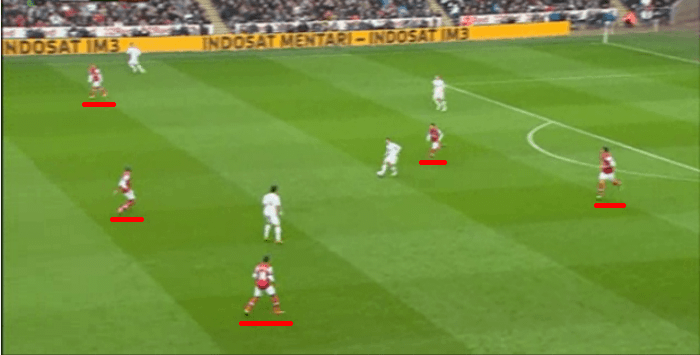
In the graphic above, Brittain avoids both Cazorla and Giroud and can pass freely to De Guzman who is not being marked tightly enough. Not only that, but the gap between the two lines is quite large. Arsenal were not compact enough showcasing the gap before the midfield
Further evidence of this can be seen in the graphic below taken a short time later. Again, Arsenal press in a disjointed fashion:-
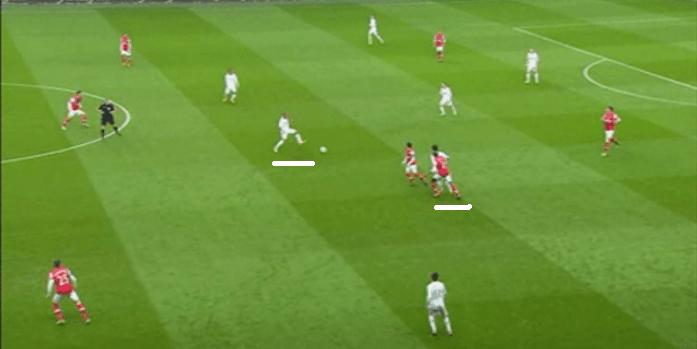
Ashely Williams played a one – two with De Guzman and can easily find space with space between Arsenal lines.
Advocates of the Arsenal press may argue that the midfield and defensive lines remained fairly compact having experienced difficulties in the North London Derby, which they did to an extent, and that pressing with the front two players can sometimes lead to errors which is also true. Against a side as technically competent as Swansea though, pressing in this manner is a waste of time and energy.
Arsenal should have begun with aggressive pressing from the outset. That sets the standard that the opposition expect and thereafter respond to. If you press fully for the opening 15 minutes of a game, the opponent then expects this to remain the case. It’s physically not possible to press for an entire 90 minutes therefore you wait for triggers; those movements by the opposition which leads to you pressing them e.g. a defender mis-controlling the ball, a player receiving a pass facing his own goal.
Once Swansea had escaped the initial press by Arsenal, the Gunners were often slow to regain their starting positions. Despite being able to counter quickly and take advantage during transitions, Swansea were very slow in possession at times. Which is quite odd in a way. Arsenal failed to prevent the problem they set out to do, stop space between their defensive and midfield lines, yet Swansea were unable to take advantage due to their own slow build up at times. When they moved between their lines, as Ki did prior to Rangel’s shot, Swansea carved out chances.
Why were Swansea so methodical in their build up?
Was this due to Michu being positioned so high up the pitch? The Spaniard would normally be driving forward from midfield, breaking into space but he was the central reference point in attack. De Guzman playing as the most advanced midfielder but he will not replicate Michu’s direct style.
Michu – Minimal Influence
It’s hard to escape the notion that had Swansea started with a traditional striker enabling Michu to begin in his favourite position, that Swansea would have caused this Arsenal backline more serious problems.
The player influence graphic below shows all players but look at how deep Michu is and how little an influence he had on the game:-
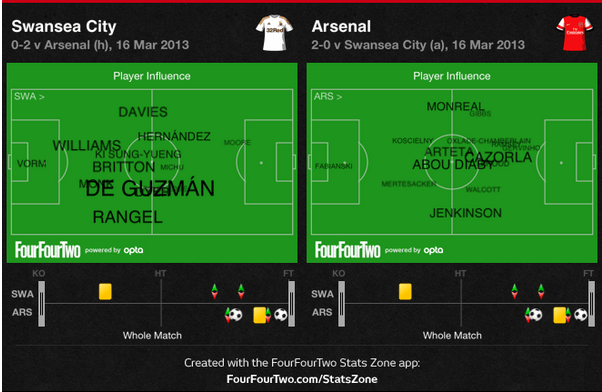
With Moore on as a late substitute, Swansea now had a central reference point in attack. Someone to occupy the Arsenal defenders enabling Michu to make the driving forward runs which he is so adept at but by this point, Swansea were chasing the game. The change happened too late.
Swansea manged just nine shots at goal with Michu responsible for three of us these but none were on target. This was an easy return to the Premier League for Fabianski. Swansea achieved too little in the final third.
Swansea were caught offside three times in the opening period perhaps that figure would have been higher had they adopted a more direct approach and tested the Arsenal defence frequently. Michu was caught out two occasions with the first an example of the problem Arsenal face with a high line. There was no pressure on the player in possession enabling the pass to be made. A slightly better timed run was all that was needed. The second occasion resulted from a long Ashely Williams clearance up field. Arsenal were holding the line near to halfway, squeezing Swansea into their own half.
Changing Tempo
The first half was all very amicable, a little too tepid. Arsenal lacked any real sense of urgency whilst Swansea were controlling the ball without controlling the game. There were opportunities to attack during transitions but neither side appeared able or willing to inject any pace to their attack and take advantage of the opportunities when they arose.
Aside from Rangel’s sliced effort, the only real chance for Swansea originated from an error by Jenkinson, carelessly passing the ball inside allowing De Guzman to intercept and pass to Michu. The shot was dragged wide. In a similar vein, Arsenal’s best chances were longer range strikes from Oxlade Chamberlain.
The second half began with Arsenal playing at a better tempo but clear chances were still rare for either side. Arsenal continued to allow space to develop between the defensive and midfield lines but Swansea were unable to exploit this. Play was becoming clogged in central midfield with only a few bursts from Cazorla really livening proceedings.
The goal altered the dynamic of the game. Swansea had to push further forward opening up space for Arsenal to counter attack into.
Santi Cazorla
With a few below par performances in recent times, there may have been some, wrong, doubts over the Spanish internationalist. The man from Asturias in northern Spain again showed his influence on the team. With a total of four shots at goal, with two on target, Cazorla displayed his ability as both a creative force and a potential goalscorer.
Cazorla was the architect of the opening goal, a surging diagonal run across the penalty area dragged the entire Swansea defence across with him. His cut back was miscontrolled by Giroud with Ramsey and Walcott unmarked at the far post. Monreal reacted quickest and scuffed his shot into the far corner to give Arsenal the lead.
From a Swansea perspective, the gap between defence and midfield is significant as is the lack of support as shown on the graphic below:-
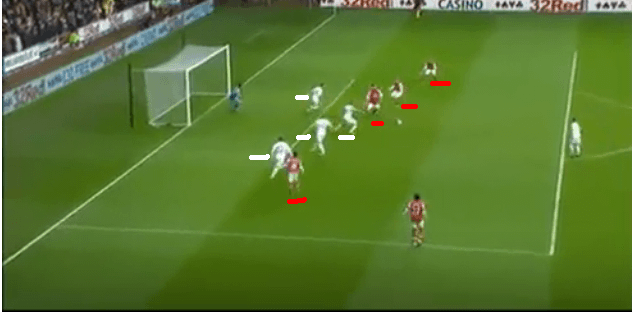
Swansea were left with a four vs four situation inside their own penalty area. The defensive line, although pulled, has retained it’s shape but nobody from the midfield has recovered their position.
Gervinho scored in injury time to seal the win following a swift counter attack. Pablo lost the ball on the left-wing and Arsenal moved the ball forward, Giroud releasing Ramsey from the halfway line. With Swansea committing men forward in search of an equaliser, Ramsey and Gervinho combined to beat Monk before scoring.
Jenkinson – Options for the Future
With the departure of Sanga in the summer likely, it offers Carl Jenkinson the opportunity to stake his claim for the right back slot.
Initially acquired as a centre back and forced to deputise at right back, Jenkinson gave the impression of a lumbering centre back playing in unknown territory at right back. Cautious when moving forward and easily exposed when dragged wide and isolated by wingers, the improvement over the season is there for all to see. This is still much room for development within his game but there is the possibility that he could settle in at right back and offer a long-term solution here.
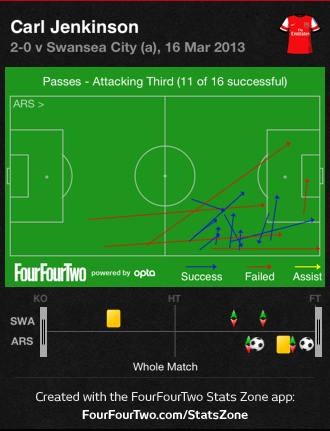
In order to do so, an improvement upon his passing and the final ball is needed especially if he is needed to provide width for the side. The above graphic shows his 16 attempted final third passes with 11 finding a team mate. As it was in the game, both sides used inverted wingers leaving it to the full backs to offer genuine width. Jenkinson is developing in his new environment.
He also offers an alternative option to. As a right sided centre back in a back three. If Arsenal wish to remain an attacking pro-active side, this is something which may need to be considered.
Conclusions
With eight games left for Swansea this season, it’s a difficult period for Laudrup. With silverware in his first season and a foray into European football guaranteed, maintaining the motivation of the squad will be his toughest challenge as the season draws to an end.
For Arsenal, three points which gained importance as the weekend progressed particularly with defeat for Spurs on Sunday. It leaves the Gunners just four points off fourth place with a game in hand at home to Reading.
The positive will outweigh the negative this weekend but there remains much work for Arsenal to grasp that coveted fourth place finish.

